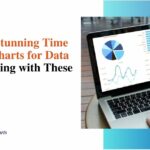Context is Key: Using Data Visualization Annotation and Labels Effectively
Even the slickest data visual requires supplemental descriptors illuminating the significance behind figures. Annotations strategically call out noteworthy aspects while quality labels directly identify measured dimensions within graphics. Getting context clues right enables diverse audiences to interpret data stories visualizations accurately aim to tell. With concise, yet carefully clarified accompaniments, clarity becomes the order of the day. In the section below, we’ll discuss about the annotation data visualization.
The role of context in data visualization
Providing proper context is crucial for annotation data visualization to be correctly interpreted. Annotations and data labels are important in establishing this context by clarifying, emphasizing, and adding informative details directly within the visualization. They guide the viewer to the key insights and conclusions when used strategically.
Purpose of Annotations and Labels
Annotations supplement a visualization by providing explanatory information highlighting key data points or trends. Labels directly name parts of the visualization to identify categories, values, axes, legends, and more. Together, annotations and labels establish a narrative within the data that creates meaningful connections for the audience.
The difference between annotations and labels
Data charts use labels to identify what important elements mean. Labels show the names of the data column headings, metrics, percentages, and other points plotted.
Annotations add helpful side notes around the chart to describe interesting things. Annotations point out why some data is higher or lower. They highlight when changes happen due to something new. Annotations guide the viewer to notice insights in the data by discussing and explaining them using regular words.
Labels are necessary so that people know what the chart numbers and axis scales represent – these turn abstract charts to real stuff. Plain labels transform confusing charts into something understandable.
Annotations then enrich understanding further after initial clarity is there. They build the story around the key data depicted to make it memorable and compelling. Annotations point out noteworthy points you may otherwise miss that deserve attention and thought.
Moreover, helpful annotations decorate charts with insightful chatter to accompany structured labels that provide baseline meaning and identification. These fraternal twins working together help people pull the most meaning from annotation data visualization.
Best practices for using annotations

Strategic placement
- Place annotations close to the relevant data points or trends they are describing. This prevents confusion and allows viewers to connect the annotation to the appropriate element intuitively.
- Use arrows, circle callouts, or underlines to tie annotations to specific parts of the visualization when helpful.
Concise but descriptive
- Balance brevity and details in your data visualization text. Avoid lengthy paragraphs, but provide enough context to clarify significance.
- Summarize key takeaways or insights related to trends and patterns discussed.
Text and graphics
- Employ a mix of textual callouts and graphical symbols like arrows, underlines, and circle callouts. This adds visual interest while maintaining clarity.
- Icons can represent recurring concepts like record highs, comparisons from previous years, etc.
Labeling techniques for maximum clarity
Here are some best practices for effective labeling techniques to maximize clarity in annotation data visualization:
- Select appropriate label types for your data: Choose quantitative labels that use specific numbers or metrics for data with precise values. When representing nominal or ordinal data, use qualitative labels to describe groups, categories or concepts.
- Format labels for scanability: Labels should have adequate white space around them and be large enough to read at a glance. Sans serif fonts have the best clarity. Be consistent with font types, sizes and alignment for uniformity.
- Strategically place labels: Position labels close to the relevant data points along axes and legends. Avoid overlapping labels and reduce clutter by only labeling key points.
- Encode labels with visual cues: Techniques like color coding, underlining, or bolding can quickly direct focus to essential labels, relating them to the appropriate data.
- Include explanatory legends: Legends are an index to decipher complex multi-variable visualizations. They define symbols, line types, colors and category labels for fast information lookup.
- Label effectively for accessibility: Simple high-contrast labels aid universal design. When possible, accompany visual labels with screen reader-compatible alt-text descriptions to optimize access.
Conclusion
In annotation data visualization, context transforms data into meaningful information. Annotations add value through descriptive details and analysis while labels establish definitions and relationships. Using them effectively guides your audience through the story hidden within the data.







